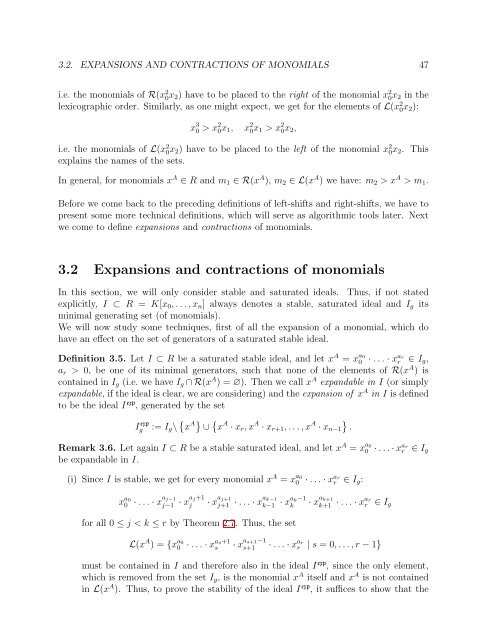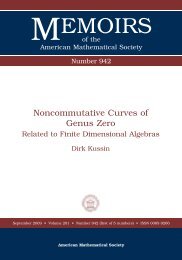University of Paderborn Department of Mathematics Diploma Thesis ...
University of Paderborn Department of Mathematics Diploma Thesis ...
University of Paderborn Department of Mathematics Diploma Thesis ...
You also want an ePaper? Increase the reach of your titles
YUMPU automatically turns print PDFs into web optimized ePapers that Google loves.
3.2. EXPANSIONS AND CONTRACTIONS OF MONOMIALS 47i.e. the monomials <strong>of</strong> R(x 2 0x 2 ) have to be placed to the right <strong>of</strong> the monomial x 2 0x 2 in thelexicographic order. Similarly, as one might expect, we get for the elements <strong>of</strong> L(x 2 0x 2 ):x 3 0 > x 2 0x 1 , x 2 0x 1 > x 2 0x 2 ,i.e. the monomials <strong>of</strong> L(x 2 0x 2 ) have to be placed to the left <strong>of</strong> the monomial x 2 0x 2 . Thisexplains the names <strong>of</strong> the sets.In general, for monomials x A ∈ R and m 1 ∈ R(x A ), m 2 ∈ L(x A ) we have: m 2 > x A > m 1 .Before we come back to the preceding definitions <strong>of</strong> left-shifts and right-shifts, we have topresent some more technical definitions, which will serve as algorithmic tools later. Nextwe come to define expansions and contractions <strong>of</strong> monomials.3.2 Expansions and contractions <strong>of</strong> monomialsIn this section, we will only consider stable and saturated ideals. Thus, if not statedexplicitly, I ⊂ R = K[x 0 , . . . , x n ] always denotes a stable, saturated ideal and I g itsminimal generating set (<strong>of</strong> monomials).We will now study some techniques, first <strong>of</strong> all the expansion <strong>of</strong> a monomial, which dohave an effect on the set <strong>of</strong> generators <strong>of</strong> a saturated stable ideal.Definition 3.5. Let I ⊂ R be a saturated stable ideal, and let x A = x a 00 · . . . · x arr ∈ I g ,a r > 0, be one <strong>of</strong> its minimal generators, such that none <strong>of</strong> the elements <strong>of</strong> R(x A ) iscontained in I g (i.e. we have I g ∩ R(x A ) = ∅). Then we call x A expandable in I (or simplyexpandable, if the ideal is clear, we are considering) and the expansion <strong>of</strong> x A in I is definedto be the ideal I exp , generated by the setI expg := I g \ { x A} ∪ { x A · x r , x A · x r+1 , . . . , x A · x n−1}.Remark 3.6. Let again I ⊂ R be a stable saturated ideal, and let x A = x a 00 · . . . · x arrbe expandable in I.(i) Since I is stable, we get for every monomial x A = x a 00 · . . . · x arr ∈ I g :x a 00 · . . . · x a j−1j−1 · xa j+1j · x a j+1j+1 · . . . · xa k−1k−1 · xa k−1k· x a k+1k+1 · . . . · xar rfor all 0 ≤ j < k ≤ r by Theorem 2.7. Thus, the setL(x A ) = {x a 00 · . . . · x as+1s · x a s+1−1s+1 · . . . · x arr | s = 0, . . . , r − 1}must be contained in I and therefore also in the ideal I exp , since the only element,which is removed from the set I g , is the monomial x A itself and x A is not containedin L(x A ). Thus, to prove the stability <strong>of</strong> the ideal I exp , it suffices to show that the∈ I g∈ I g
















